This is a story of everyday researchers and teachers, struggling to do their job in a world pervaded by management bollocks.
This page is a continuation of the diary that started in June 2007, with the demise of UCL’s Pharmacology department (for the time being). It continued
- from June 2008 to May 2009 on a separate page.
- From June 2009 to May 2010
- From June 2010 to May 2011
- From June 2011 to May 2012
- From June 2012 to May 2013
- From June 2013 to May 2014
- From June 2014 to May 2015
Now we continue from June 2015.
Links. Items on this page can be linked directly by appending the date to the page link, e.g. adding /#030715 takes you directly to the entry for 3 July 2015. Thus https://www.dcscience.net/in-memoriam/the-diary-june-2015-may-2016/#030715.
2 June 2015
The first meeting of the Royal Society diversity committee. It’s chaired by Uta Frith. When she first invited me to join, I thought that the problem had almost disappeared, at least for women. Events rapidly proved me wrong.
18 June 2015
Today I gave a seminar in UCL’s Department of Staistical Science, It was the first time that I’d talked about false discovery rates to a roomful of professional statisticians. I was encouraged to get, a couple of days before the talk, a friendly email from none other than David Cox (now 90 years old). I’d expected to be massacred by fundamentalist Bayesians, but in the event my general conclusions seemed to be accepted. Phew.
21 June 2015
Invited to barbecue lunch by my son Andrew, and his wife Natalie. Their new flat has an excellent roof terrace.
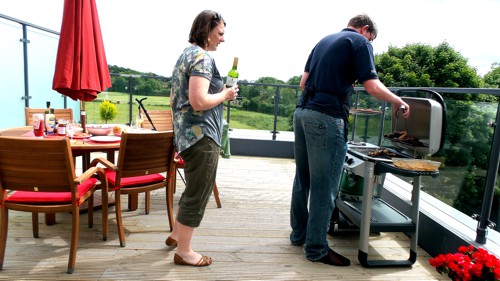
1 July 2015
The Royal Society soiree. More boring than usual, though Paul Nurse seems to have forgiven me for the Prince Andrew fuss. Perhaps that was because of my support over the Tim Hunt affair.
3 July 2015
One of this interesting occasions when one meets in real life someone whom you’ve previously known only through the blogosphere. Jennifer Raff dropped into UCL while on her honeymoon in Europe. She’s interested in ancient DNA and in the origins of native Americans. I’ve learned a lot about that from her blog, Violent Metaphors. She’s also done great public service in keeping creationism out of Texas school textbooks, and in opposing anti-vaccination wingnuts: her essay "Dear Parents, You Are Being Lied To" is a classic. She’s also an athlete (she competed in the Golden Gloves amateur boxing contest in 2012, as well as Muay Thai and MMA). She was as impressive as I’d expected,
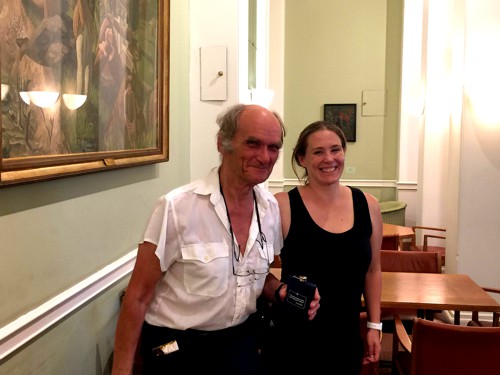
7 – 17 July 2015
Ten days in the Austrian Alps. Went by train the whole way to Jenbach. The Sud Tirol scenery is beautiful, though these days I’m no longer able to do long walks in the mountains. far less run.
Here is an album of pictures (mostly boring -there are better mountain pictures from a few years ago).
This is Schloss Kufstein: the organ manual is in the hut. The pipes are in the castle.
Click for album.
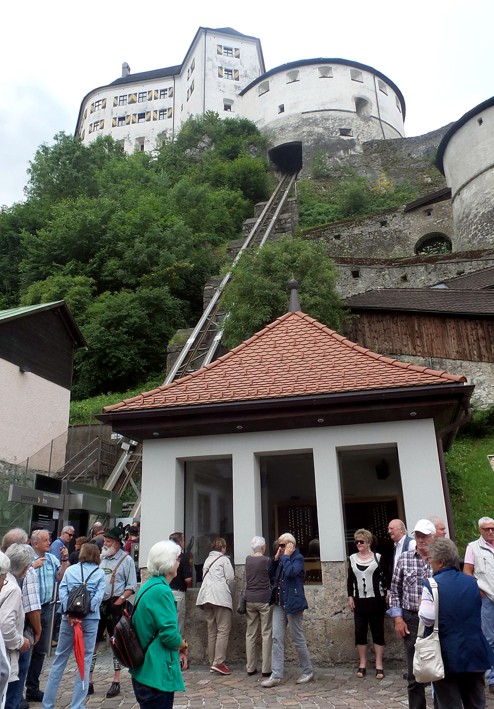
26 July 2015
Garden party, the excuse being my 79th birthday and Margaret’s 64th. For the first time ever, the weather was appalling. It poured down all day. So it was rather crowded indoors, but people chatted happily anyway. Weather was so appalling that I made a batch of Glühwein -it proved quite popular.
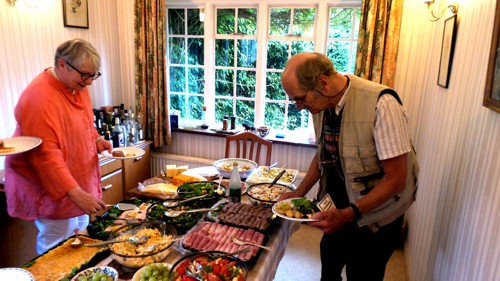
Uta Frith and DC attack the food
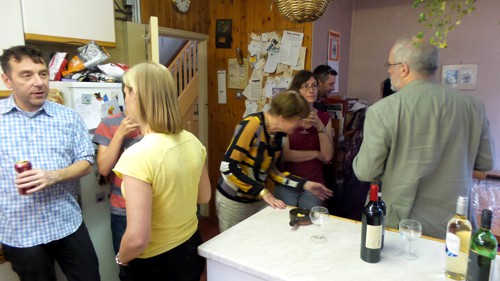
Jon Butterworth (Physics UCL and LHC), Lesley Anson, Margaret, Maria Mclachlan and Alan Henness in the kitchen.
29 July 2015
Through an encounter on Twitter, I met the education commentator, Donald Clark for the first time in real life. I often like his blog. Donald Clark Plan B. I first came across this blog because of its posts on “neurolinguistic progarmming” (NLP). More recently, I especially like “Chief Happiness Officers – send in the clowns?“
7 August 2015
Went to Bricklayer’s Arms for a great (but expensive) lunch for Margaret’s birthday.
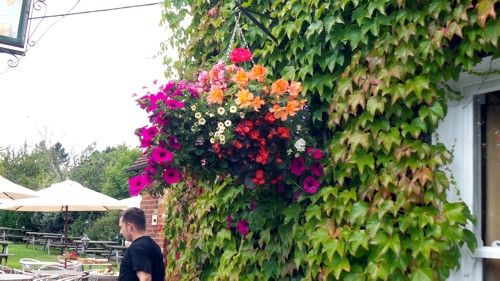
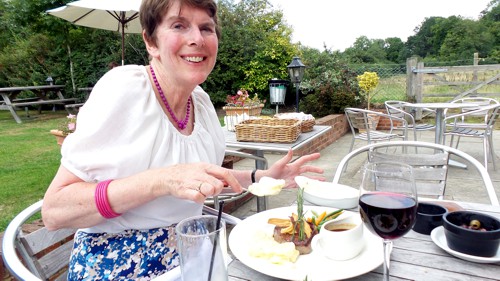
18 August 2015
This is one for people who are interested in the history of physiology and biophysics. We had a visit from William (Liam) Burke. He is now 94 and quite spry. Burke was one of the five PhD students of Bernard Katz, in the heyday of UCL’s biophysics department (see my obituary of Bernard Katz), Burke finished his PhD in 1956, the same year when my colleague, Donald Jenkinson, started. In 1956 he published two papers in the Journal of Physiology (1956a and 1956b), co-authored with Bernard Ginsborg. It was the first time I met Burke (though many years ago, he tempted me to follow him to Australia, when the chair of pharmacology became vacant).
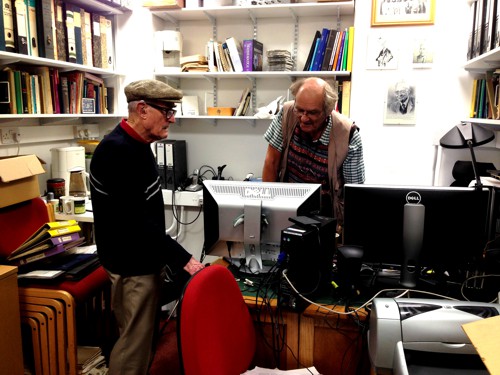
Liam Burke in my office, inspecting my desk, which I inherited from Bernard Katz after he died in 2003.
I got to know Ginsborg well during my PhD in Edinburgh (1960 -1964). My biggest mistake was not having Bernard as my supervisor. He got me interested in electrophysiology and I learned a huge amount from a
review that he published in 1967. His background in physics reinforced my interest in quantitative approaches (he had done his PhD in optics with R.W. Ditchburn). For many years, Bernard invited me to talk to his students in Edinburgh. His house was lined with books, all of which he seemed to have read. Here are a couple of pictures taken in December 1985 (one year after our son’s dramatic birth).
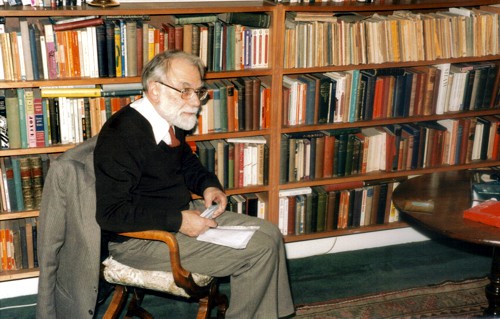
Bernard Ginsborg, in December 1985. His sparkling intellect was an inspiration.
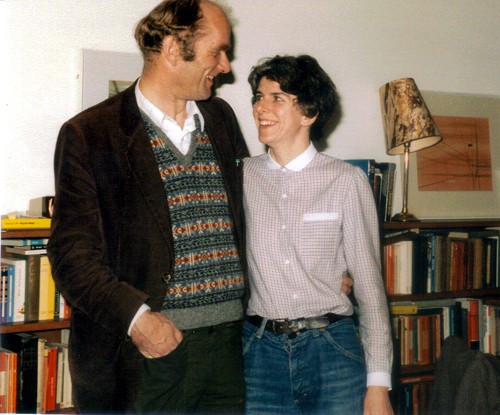
Margaret, at Ginsborg’s house, in December 1985, one year after Andrew’s dramatic birth
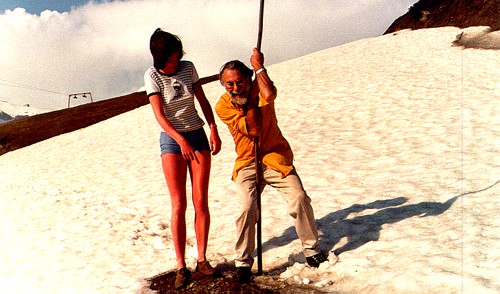
The only other picture of Ginsborg that I have.. Taken, with Margaret, on a snow-covered Swiss mountain during a meeting at Crans-sur-Sierre, in May 1977. We’d been married for only a year.
19 August 2015
Another piece on statistics will appear in Chalkdust, a magazine run by postgraduate students in the maths department at UCL. The article starts with a description of randomisation tests. That’s something I’ve loved ever since I wrote Lectures on Biostatistics in the late 1960s (download it -link at top of left sidebar). The problem with print is that it’s stationary. To complement the article, I made a short movie version that explains randomisation tests with animations.
v
This, with the earlier movie about the false discovery rate, covers most of the article.
6 – 17 September 2015
My annual trip to Plymouth for two talks on single ion channel kinetics at the Microelectrode techniques workshop. This was the 32nd time that this excellent practical course has run, thanks to the heroic efforts of ny old friend David Ogden. I’ve missed it only once. This year I was asked to give an extra talk about the interpretation of P values. Earlier on the trip I spent a day at the annual meeting of the Royal Statistical Society in Exeter, where I talked about P values in two different sessions.
In recent years, I’ve taken to driving, rather than taking the train: I miss the beautiful, but vulnerable, bit of the line between Dawlish and Teignmouth. But driving allows us to turn the trip into a mini-holiday, calling in at various friends en route. This year we visited Andy Lewis (@lecanardnoir) and family in Somerset, and Melanie & Richard Byng, as well as nights in Dartmouth and Buckler’s Hard, both of which evoke many memories from sailing days. Here are a few pictures.
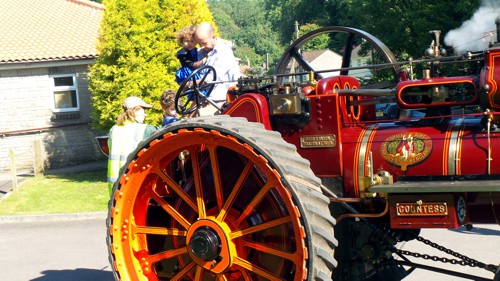
Andy Lewis and kids at village fun.
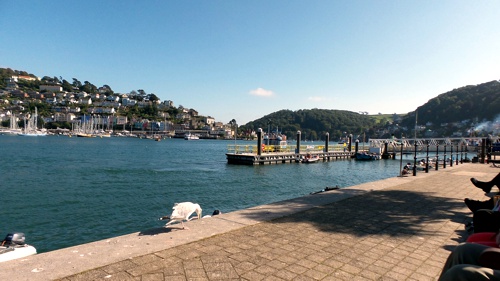
Dartmouth.
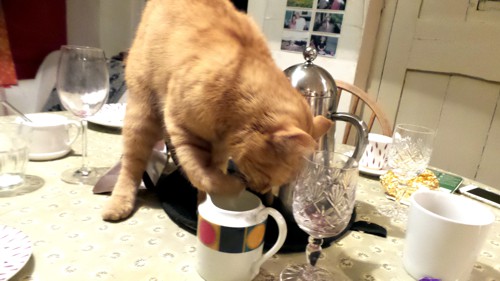
Melanie’s cat helps itself to milk.
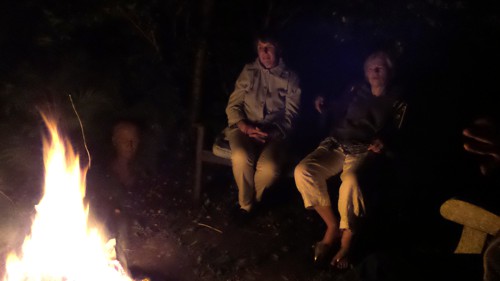
Putting the world to right, round fire after dinner
25 September 2015
Today is the first anniversary of the death of Stefan Grimm. He killed himself after being put under impossible pressure by Imperial College’s stupid "performance management" bullies.
With the help of his mother and sister, I have posted a memorial. The lessons of his needless death must not be forgotten.
6 October 2015
Party in the maths department at UCL, for the launch of the second issue of Chalkdust magazine. I had a piece in it. There are pictures in a post, in which I decode the meaning of the equations on the Chalkdust T shirt.
12 October 2015
I was asked to take part in a phone-in programme on BBC Radio Essex, at 07.10. It was about the advertisement that had appeared for spiritual healers to work at an NHS hospital. I was on with Victoria Robertson, who seeded to think that she could act as a television antenna to "channel energy" into a patients body. Her web site says "I’m often asked along to talk and demostrate [sic] to people about Reiki and complimentry [sic] therapies". I’ve written about "spiritual healers" before. It’s partly a problem of dim-witted Human Resources people who seem to think that a certificate in spiritual healing is worth the paper it’s written on. But it enables them to tick a box. with no intervention of the brain.
Here is a recording of the interview. ![]()
14 October 2015 Went to the second meeting of the Royal Society diversity committee. A really good bunch of people.
16 October 2915. Margaret got a "highly commended" certificate for her work on our garden. It was presented at the local cricket club.
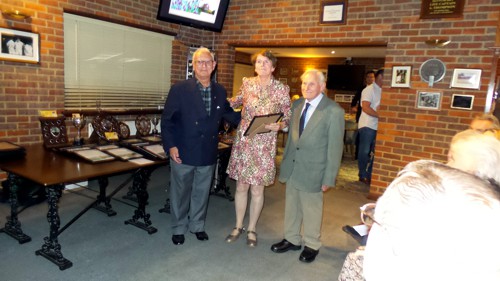
Here is her Euonymus.
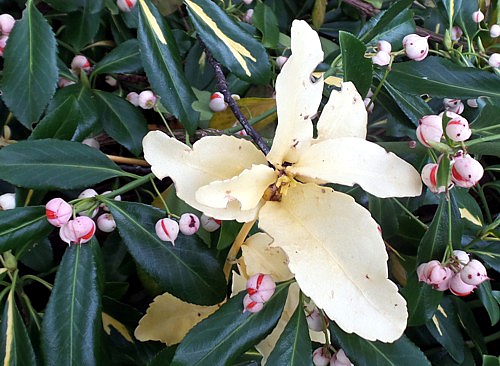
20 October 2015
Went to a focus group run for the Higher Education Academy. I was the only academic there. A wasted afternoon.
In the evening, went to the Healthwatch dinner and saw the Healthwatch award given to Dr Mark Porter. His Radio 4 programme, Inside Health, is the best on Radio and TV. It often features the excellent Dr Margaret McCartney (she got the award in 2008). After the dinner we had an interesting discussion of the misinterpetation of P values (I maintain that the simplified version that they gave in the programme was oversimplified).
3 November 2015 Went to the Sense About Science reception -many old friends there and glad to see the John Maddox prize awarded jointly to Edzard Ernst and Susan Jebb.
11 November 2012.
Spent two hours being filmed for a BBC documentary on "supplements". The presenter, Fiona Phillips, gave me an easy ride, and seemed genuinely interested. Heaven knows how much will end up in the final documentary (out next year)
14 November 2015. Had lunch with two (high-powered) mathematicians, Dmitri Vassiliev (UCL) (and on Facebook) and John Toland (head of the Newton Institute). Lovely people,
24 November 2015

A while ago I was asked by Jeremy Garwood to do an interview for Lab Times ("A news magazine for European Life Sciences"). Being asked to do that sort of thing seems to be a penalty of age.
It went on-line today, under the title "Bibliometricians are really the curse of the age" (that was the quotation that they chose). The on-line version had a bit more about my pre-blogging science than the printed version, but that’s not what they were really interested in. Hey ho.
30 November 2015. Went to see Suffragette. A really good movie. The original footage of the funeral of Emily Wilding Davidson at the end was very moving
3 December 2015
Went to dinner at Royal Society with a lot of other UCL Fs. The idea was to meet the new president, Venki Ramakrishnan. He seemed to be a really nice bloke, gently spoken, very sensible.
On 30 November I was asked by James Wilsdon to contribute to a Guardian blog “A vision for Venki: where next for the Royal Society?“
4 December 2015
Went to Kings College to give my annual talk about alternative medicine to clinical pharmacology undergraduates. Got some really good questions -they seem to be particularly interested in the misinterpretation of P values.
That topic seems to be getting through to a wide range of people, judging by the fact that the paper, An investigation of the false discovery rate and the misinterpretation of p-values, has had 91,000 full text views and 11,800 pdf downloads in little more than a year
6 December 2015. A colleague is fostering a new kitten. It’s really very pretty.
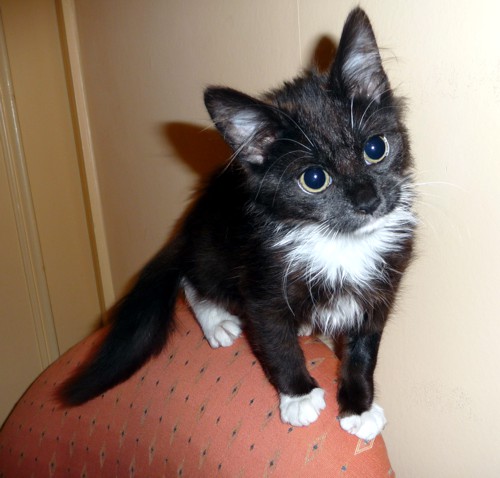
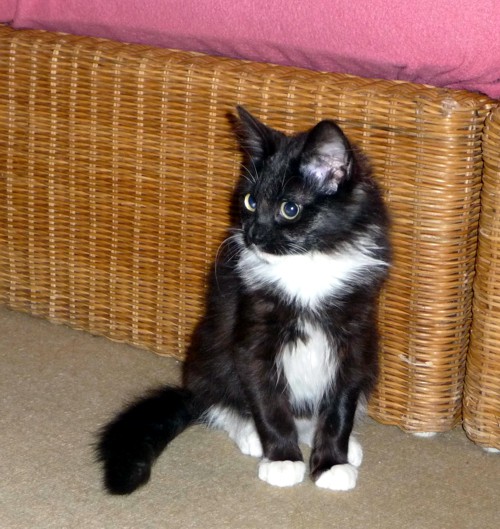
14 December 2015
Got a note from Royal Society Publishing about my paper, "An investigation of the false discovery rate and the misinterpretation of p-values". The note was to tell me that the paper was number 33 in the top 100 altmetric scores for 2015. Ironically, the discussion of the paper includes the words
"The mis-assessment of individuals by silly bibliometric methods has contributed to this harm. Of all the proposed methods, ‘altmetrics’ is demonstrably the most idiotic [12]. "
The fact that it’s had almost 95,000 full text views and 12,400 pdf downloads has, I think, nothing to do with quality or originality. The quality doesn’t come within a million miles of things connected with my real job. for example Joint distributions of apparent open times and shut times of single ion channels and the maximum likelihood fitting of mechanisms.(Colquhoun, D., Hawkes, A. G. & Srodzinski, K. 1996.Philosophical Transactions of the Royal Society London A 354, 2555–2590). But the audience for stuff like that is quite small, because it’s quite mathematical, because of the limited number of people who are doing single ion channel kinetics, and because the results are incorporated into a computer program
Rather it has to do with three quite different things. (1) The results are relevant to any field of science that uses tests of statistical significance, i.e., most of them. (2) The paper is written in a simple style: much easier to read than most papers by professional statisticians. (3) I have nothing better to do these days than to spend time publicising the results on twitter. These considerations confirm my view that there’s a negative correlation between altmetric score and quality of the paper (see, for example, Why you should ignore altmetrics and other bibliometric nightmares, and some examples of hype.
16 December 2015
Went to the annual meeting of the British Pharmacological Society. At the dinner I got presented with the Wellcome Gold Medal. Although my days in single channel analyis are now almost done, it was nice to have past work recognised. Since 2004, the single channel work at UCL has been run by Prof Lucia Sivilotti, the present holder of the AJ Clark chair.
At least half of the credit for this prize belongs to the ace probabilist, Alan Hawkes, without whose brilliant mathematics most of the work would have been impossible.
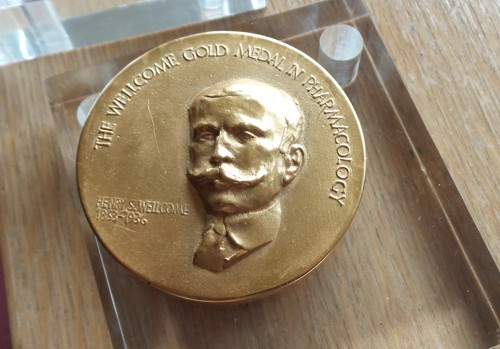
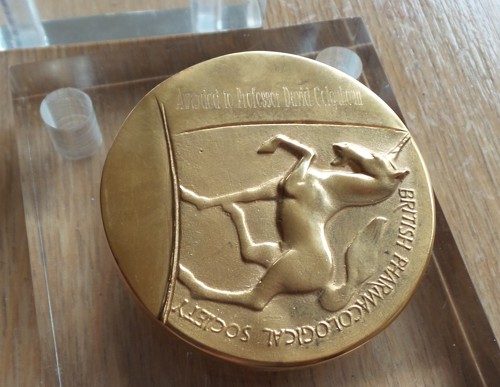
25 December 2015
Christmas isn’t quite the same without kids. We may be a bunch of atheists in this house, and our son as flown the nest, but there’s nothing wrong with a bit of cosy tradition on christmas eve.
Log fire, grandma (94) on phone to her grandson, christmas tree and The Snowman.
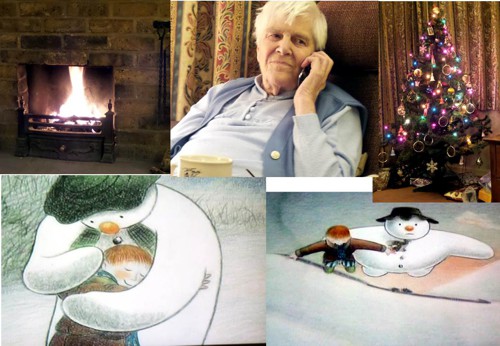
31 December 2015
This picture is a new year candle. To my astonishment, it was sent to me by the sister of the late Stefan Grimm. I really hope that she, and her mother, manage to find happiness in 2016.
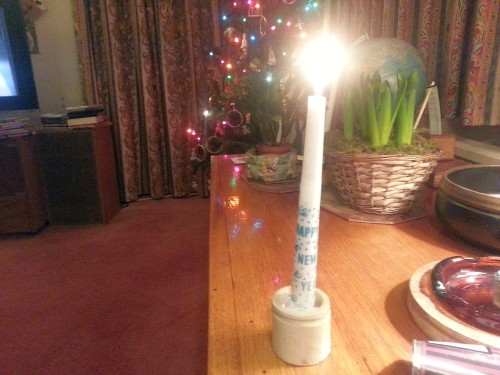
11 Jan 2016
I met Gerta Vrbová (born 1926, in Slovakia) for lunch in the Housman room. She wrote “Archibald V. Hill’s contribution to science and society” [download pdf]. See more details in my post On Archibald Vivien Hill and the honours list.
12 January 2016
I agreed to take part in an Al Jazeera English programme, on (sigh) homeopathy. Some of my friends had already declined. They were right. The hosts were genial enough but clueless. They seemed to think that there was some sort of controversy. There isn’t.
On the side of the quacks were Peter Fisher, about whom so much has been written on this blog and Michelle Dossett fo the Benson Henry Institute for Mind Body Medicine. There was also a psychologist who thought everything as explained by powerful placebo effects. It isn’t.
You can watch the video here if you really want to, but it won’t be time well spent.
.
26 Jan 2016
Had lunch with Deborah Mayo. She’s a philosopher of statistics, and it’s on her blog where most of the opposition to my ideas about interpretation of P values has appeared. I’ll confess that I found her objections hard to follow. Stephen Senn’s posts on Mayo’s blog are easier to follow. He points out that disgreements about interpretation are about Bayesian vs Bayesian rather than frequentist vs Bayesian. He’s right but I can’t get excited about the internecine warfare between frequantists and Bayesians, and there are comments on that both in my paper, and in the comments that follow it.
In the afternoon, I met Clive Stafford Smith, the great human rights lawyer and chair of Reprieve. He was a delightful person as well as something of a hero to me. The meeting was arranged through twitter.
27 Jan 2016
Today was the day of my talk on P values. It was organised by my catchily-named, and over-sized, department, Neuroscience, Physiology and Pharmacology so it was a bit less technical than the version that I gave that I gave last June to UCL’s statistics department. Very conveniently, the paper reached 100,000 full text views on the Sunday before the talk. That provided another good excuse to point out the silliness of trying to judge quality of work by bibliometrics.
Having advertised the talk on Facebook and Twitter. i thought that the usual venue, the H.O.Schild lecture theatre (formerly the Pharmacology theatre) might be too small, so it was held in the second largest theatre in the Cruciform building (the former hospital) and that proved to be about right.
Im the evening I had promised to go to the AGM of the Council for the Defence of British Universities (CDBU) but I was just too tired. Must be getting old, dammit.
2 February 2016
Made my first visit to the Department of Health, on Whitehall. I’d been invited to meet the Minister for Life Sciences, George Freeman. to discuss (yawn) the regulation of herbalists. This is a saga that’s been going on for 16 years. The execrable Pitillo report recommended statutory regulation of herbalists, and degree level qualifications. In 2008, I wrote A very bad report: gamma minus for the vice-chancellor. The Labour government of the time had commissioned the report, but the people who wrote it were all quacks, so it’s not surprising that the report advocated quackery. Subsequently, I wrote several times about this report, In the Times in 2008, and in the British Medical Journal in 2009. Responses were printed in the BMJ in 2010. I also submtted a reponse to the consultation on the Pittlo report,
Luckily all this opposition caused the government to kick the matter into touch, yet again. The, in early 2014, the Tory-led government set up yet another body, “Herbal Medicines and Practitioners Working Group ” (HMPWG). My heart sank when I saw itsmembership (Annex A.2). The vice-chair was none other that the notorious David Tredinnick MP (Con, Bosworth). This committee, or at least it chair, David Walker (the deputy chief medical officer) produced an excellent report which identified all the absurdities if trying use statutory regulation on a form of medicine that has produced not a single useful treatment, That seemed to end the matter for good and I wrote up the saga in Herbs get the push: no statutory regulation for western herbalists or Traditional Chinese Medicine.
But it’s not so simple. The meeting today was to discuss Walker’s report. I had onll one ally, Dick Taverne. Everybody else was some sort of advocate of quackery. They were all familiar names, but this was the first time I’d met most of them face to face.
George Freeman, Minister for Life Sciences
Professor David Walker (by telephone)
David Tredinnick (of astrology fame, and cash for questions)
Lord Hunt of Kings Heath (who famously referred to psychic surgery as a "profession")
Michael Dixon (lately of the Prince of Wales for Magic Medicine)
Michael McIntyre (chairman of the industry lobby group, the European Herbal and Traditional Medicine Practitioners Association)
Emma Farrant (CEO of Register of Chinese Herbal Medicine and acupuncturist)
Simon Mills (Herbalist, of "hot and cold medicine% fame)
Lord Taverne
Professor David Colquhoun FRS
Professor Edzard Ernst (declined tne invitation to attend)
Adam Smith (herbalist and "naturopath")
It felt weird that, in 2016, such a group of dedicated anti-science people should be invited to the Department of Health. But despite the blunt things I’ve written about some of them, everyone was quite civil.
The minister, George Freeman, was inscrutable, but he’s had a lot to do with pharma startups so he should be aware of the idea that a treatment needs to be shown to work. Together with Walker’s report, that leaves me quite optimistic. It remains to be seen if he can resist the incessant pressure from the industry, and David Tredinnick MP.
11 February 2016
Went to hear the Faraday lecture at the Royal Society. It was followed by a meet-the-media reception,
12 February 2016
A short interview about cough medicines. It was made by 7 Wonder for the BBC. It was meant to be shown today, but got cut at the last minute..
More details about over-the-counter cough medicines can be found in Some medicines that don’t work. Why doesn’t the MHRA tell us honestly?
And more information about honey in Why honey isn’t a wonder cough cure: more academic spin
18 February 2016
Met Kristina Clackson Bonnington for lunch. She’s the artist behind the forthcoming UCL exhibition about the legacy of women’s suffrage. She wanted to talk about the time, in the late 1960s, when the senior common room at UCL voted to admit women. I’ve written on this blog about the history of that time.
23 February 2016
Went to lunch hour lecture by UCL mathematician, Helen Wilson. You can see it on YouTube.
9 March 2016
The International Women’s day exhibit opened at UCL, in the north cloisters. There is a booklet that describes the exhibition.
This is what Kristina Clackson Bonnington produced about my own small contribution.
Me with artist.
And the crowd at the exhibition. Kristina is talking to sculptor Edward Allington (in the big hat).
14 March 2016
Went to the maths department for the party for the launch of issue 3 of the excellent Chalkdust magazine. My article in the 2nd issue seemed to provoke some interest.
6 April 2016
It was a great pleasure to meet again Steven Siegelbaum, as he passed through London. He was the secon foreign postdoc in my erstwhile lab, and went on to be very successful.
14 April 2016
Drove to the University of Wolverhampton. Because of interchanges on twitter, I was asked by Ian Lahart (senior lecturer in exercise physiology) to contribute to the British Association of Sport and Excercise Science (BASES) meeting of their Division of Physical Activity for Health. I’ve been pretty critical of the quality of evidence that’s been used to promote exercise as a panacea for almost every ill. The problem is that exercise has become a buzzword, and it’s too often promoted by evangelism rather than good evidence. It’s no surprise that it’s promoted most strongly for conditions for which no effective treatments exist, for example, depression. There is a real danger that this will lead to "cluching at straws". This is what led to the promotion of acupuncture for low back pain (now rescinded, because it doesn’t work). My talk was "The misinterpretation of P values and other hazards in sports research”.
15 – 17 April 2016
After the Wolverhampton meeting we spent a night at the Lion and Pheasant, in Shrewsbury, before driving on to Gregynog. It was our first visit to Shrewsbury -an attractive town.
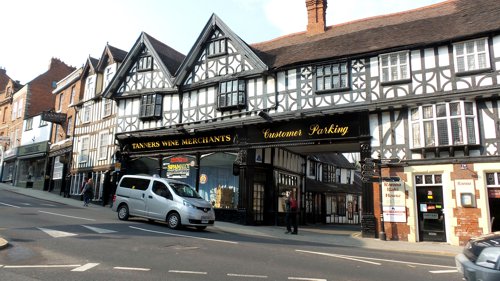
The food at the Lion and Pheasant was great quality (and price), though a bit lacking in quantity, not least the Welsh lamb.
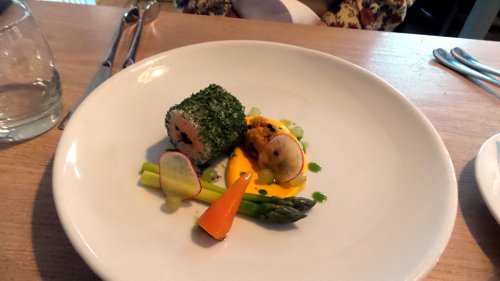
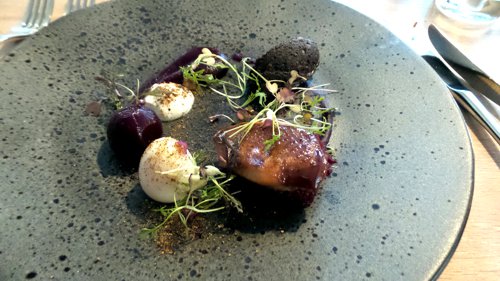
On the drive to Gregynog, we saw lots of Welsh lamb. This only exacerbated my guilt at having eaten lamb the previous evening.
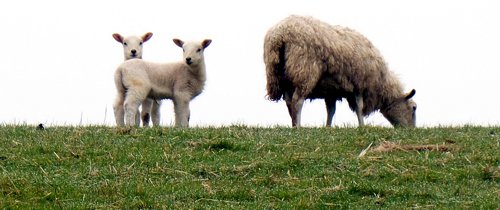
Gregynog Hall was the site of a 52nd Gregynog Statistical conference organised by the University of Warwick. The last time I was there was for the 26th conference in 1990, when I talked about "Looking at single molecules: ion channel properties as a Markov process". That was just before Alan Hawkes found the exact solution to the missed events problem, so allowing us to do maximum likelihood fits, This time it was "The misinterpretation of P values and the reproducibility of science:why haven’t statisticians told us?”. The abstract booklet has some history of the Gregynog estate. My abstract was as follows.
There’s nothing wrong with P values. They do what it says on the tin. The problem lies in the fact that what they do is not what experimenters want. What they want to know is the probability that, if they claim an effect is real, they’ll be wrong. Many experimenters believe that this is what the P value tells you, but of course it isn’t. It is easy to show that, if you observe P = 0.047 in a single test of significance, and claim on that basis that the effect is real, you’ll be wrong at least 26% of the time (and a great deal more often if the hypothesis is implausible) – eg see http://rsos.royalsocietypublishing.org/content/1/3/140216. This alone is sufficient to account for much of the reproducibility crisis that has engulfed some areas of science, e.g. experimental psychology. Although the argument behind this conclusion is Bayesian (which is probably why I took so long to notice it), I believe that it is free of any subjective elements. By failing to emphasize this in elementary courses, and by being complicit in allowing the tyranny of P = 0.05 in papers, I fear that statisticians may have contributed to the irreproducibility crisis that it is their job to prevent.
Despite the fact that I was slagging off the audience, there was no real dissent from the conclusions.
After the first (Friday) night we were surprised to wake to a thin covering of snow.
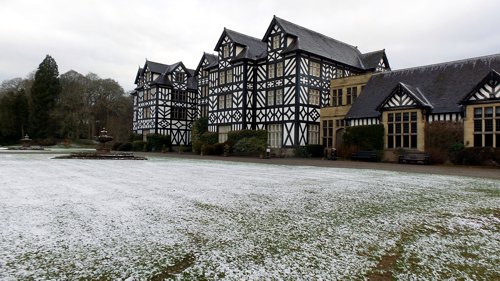
But it soon vanished and we got a a couple of decent walk (thanks to my new rollator).
In the afternoon we walked with Alan Hawkes, whom I met in the late 1960s, and with whom I’ve been writing papers ever since. My whole career is based on his amazing ability to work out the mathematics of stochastic processes.
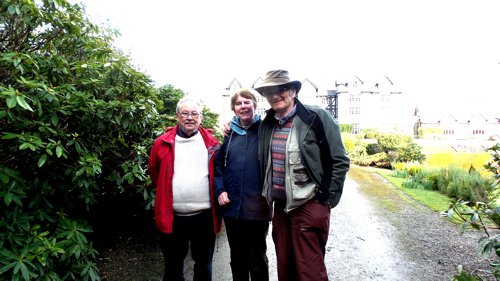 .
.
The meeting coincided with the Gregynog Young Musicician of the Year competition. We heard music all day on Saturday, and in the evening we went to the final. The standard was breathtaking. The winner was an Kirsty Chaplin (age 17).
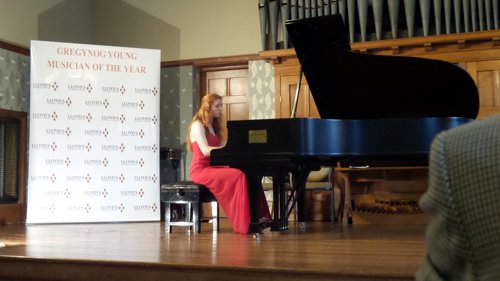
She gave a thunderous and dramatic performance of a Liszt Transcendental Etude. You can hear it on Youtube.
22 April 2016
Went for dinner at Rules, near Covent Garden, for our 40th wedding anniversary (at those prices it’s an infrequent treat). Amazing place.
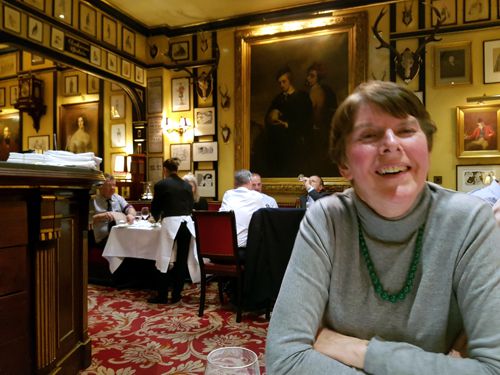
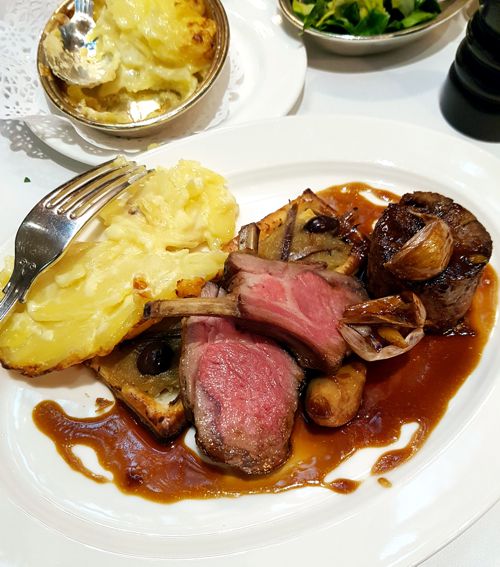
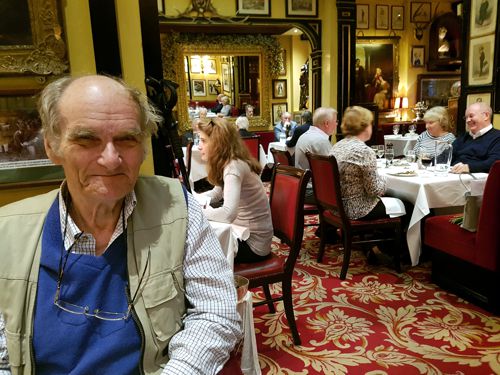
3 May 2016<
A debate at the London Wine Fair. I tried to explain Mendelian randomisation as evidence against there being any dose of alcohol that benefitted your health. My opponent was Tony Edwards. He trotted out all the dodgy epidemiology that has been tirelessly promoted by Christopher Snowdon and othe libertarians. The last time I met him was around 1991 when he asked me to contribute to a QED programme about homeopathy. The programme was ghastly and my views were misrepresented. At least I got half a dozen bottles of good wine for my birthday party.
4 May 2016
To Cumberland Lodge for another talk about false positive rates.
10 May 2014
Lunch with Christopher van Tulleken. He makes very watchable TV programmes, though the results of his live experiments are sometimes dubious.
Continued. The diary will now continue on a new page: The diary, June 2016 – May 2017

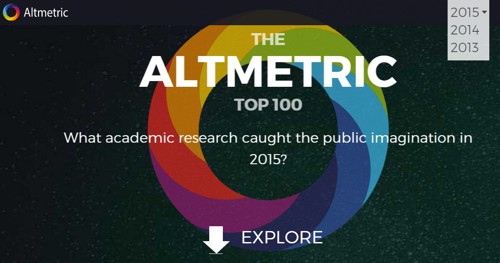
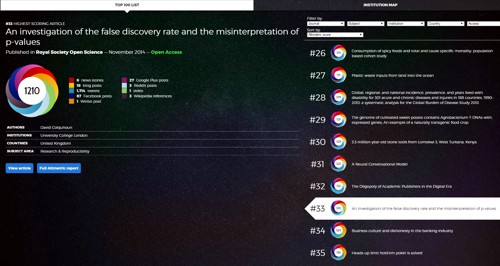
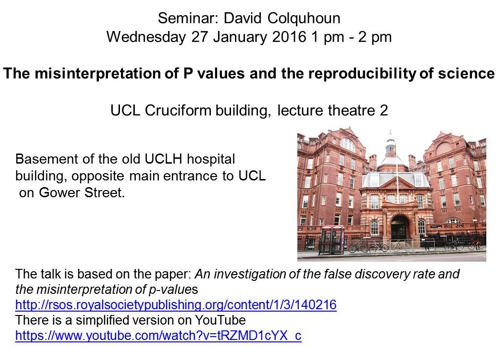
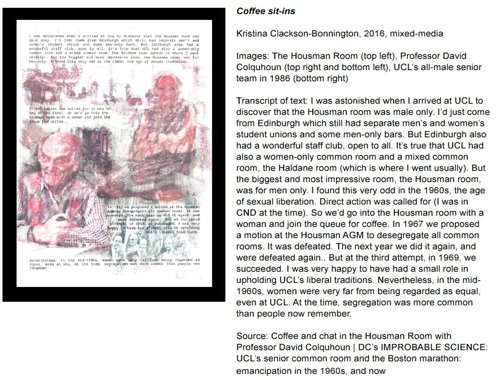
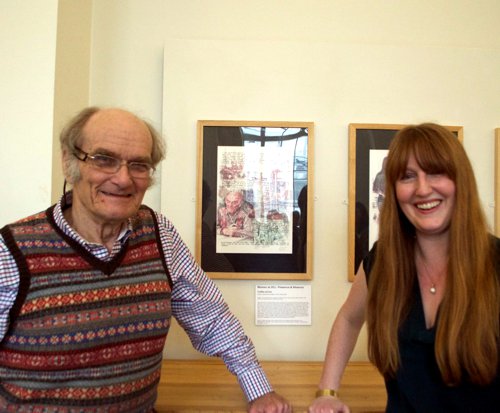
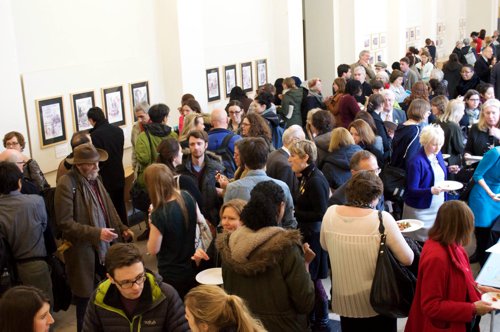
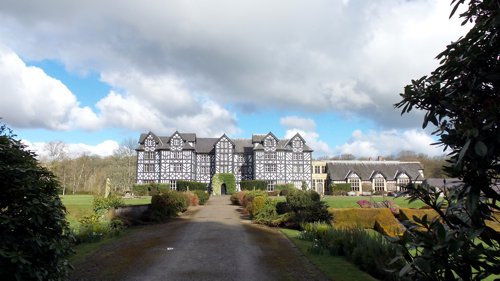

Hi David,
have you given up on your dcscience blog ?
Haven’t seen anything posted for ages 🙁
Not at all. The last post was on March 24 (and April 17 in the diary). I write posts when I have something to say, not according to a timetable.
Thanks David. Didn’t mean to hassle you.
Actually, I now use FB more than before, for quick posts -especially for more political stuff.
https://www.facebook.com/david.colquhoun.731